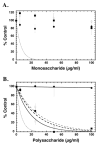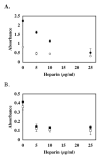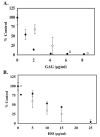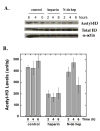Inhibition of histone acetyltransferase by glycosaminoglycans
- PMID: 18459114
- PMCID: PMC2596351
- DOI: 10.1002/jcb.21803
Inhibition of histone acetyltransferase by glycosaminoglycans
Abstract
Histone acetyltransferases (HATs) are a class of enzymes that participate in modulating chromatin structure and gene expression. Altered HAT activity has been implicated in a number of diseases, yet little is known about the regulation of HATs. In this study, we report that glycosaminoglycans (GAGs) are potent inhibitors of p300 and pCAF HAT activities in vitro, with heparin and heparan sulfate proteoglycans (HSPGs) being the most potent inhibitors. The mechanism of inhibition by heparin was investigated. The ability of heparin to inhibit HAT activity was in part dependent upon its size and structure, as small heparin-derived oligosaccharides (>8 sugars) and N-desulfated or O-desulfated heparin showed reduced inhibitory activity. Heparin was shown to bind to pCAF; and enzyme assays indicated that heparin shows the characteristics of a competitive-like inhibitor causing an approximately 50-fold increase in the apparent Km of pCAF for histone H4. HSPGs isolated from corneal and pulmonary fibroblasts inhibited HAT activity with similar effectiveness as heparin. As evidence that endogenous GAGs might be involved in modulating histone acetylation, the direct addition of heparin to pulmonary fibroblasts resulted in an approximately 50% reduction of histone H3 acetylation after 6 h of treatment. In addition, Chinese hamster ovary cells deficient in GAG synthesis showed increased levels of acetylated histone H3 compared to wild-type parent cells. GAGs represent a new class of HAT inhibitors that might participate in modulating cell function by regulating histone acetylation.
(c) 2008 Wiley-Liss, Inc.
Figures











Similar articles
-
Isothiazolones as inhibitors of PCAF and p300 histone acetyltransferase activity.Mol Cancer Ther. 2005 Oct;4(10):1521-32. doi: 10.1158/1535-7163.MCT-05-0135. Mol Cancer Ther. 2005. PMID: 16227401
-
The scaffolding protein JADE1 physically links the acetyltransferase subunit HBO1 with its histone H3-H4 substrate.J Biol Chem. 2018 Mar 23;293(12):4498-4509. doi: 10.1074/jbc.RA117.000677. Epub 2018 Jan 30. J Biol Chem. 2018. PMID: 29382722 Free PMC article.
-
MRG15 activates the cdc2 promoter via histone acetylation in human cells.Exp Cell Res. 2011 Jul 1;317(11):1534-40. doi: 10.1016/j.yexcr.2011.02.001. Epub 2011 Feb 14. Exp Cell Res. 2011. PMID: 21324423 Free PMC article.
-
Histone acetyltransferases: challenges in targeting bi-substrate enzymes.Clin Epigenetics. 2016 May 26;8:59. doi: 10.1186/s13148-016-0225-2. eCollection 2016. Clin Epigenetics. 2016. PMID: 27231488 Free PMC article. Review.
-
Histone acetyl transferases as emerging drug targets.Drug Discov Today. 2009 Oct;14(19-20):942-8. doi: 10.1016/j.drudis.2009.06.008. Epub 2009 Jul 2. Drug Discov Today. 2009. PMID: 19577000 Review.
Cited by
-
Upregulation of ERK-EGR1-heparanase axis by HDAC inhibitors provides targets for rational therapeutic intervention in synovial sarcoma.J Exp Clin Cancer Res. 2021 Dec 2;40(1):381. doi: 10.1186/s13046-021-02150-y. J Exp Clin Cancer Res. 2021. PMID: 34857011 Free PMC article.
-
Heparan sulfate-protein binding specificity.Biochemistry (Mosc). 2013 Jul;78(7):726-35. doi: 10.1134/S0006297913070055. Biochemistry (Mosc). 2013. PMID: 24010836 Free PMC article. Review.
-
The heparanase/syndecan-1 axis in cancer: mechanisms and therapies.FEBS J. 2013 May;280(10):2294-306. doi: 10.1111/febs.12168. Epub 2013 Mar 4. FEBS J. 2013. PMID: 23374281 Free PMC article. Review.
-
A computational approach for deciphering the organization of glycosaminoglycans.PLoS One. 2010 Feb 23;5(2):e9389. doi: 10.1371/journal.pone.0009389. PLoS One. 2010. PMID: 20186334 Free PMC article.
-
Heparanase regulates levels of syndecan-1 in the nucleus.PLoS One. 2009;4(3):e4947. doi: 10.1371/journal.pone.0004947. Epub 2009 Mar 23. PLoS One. 2009. PMID: 19305494 Free PMC article.
References
-
- Ait-Si-Ali S, Ramirez S, Barre FX, Dkhissi F, Magnaghi-Jaulin L, Girault JA, Robin P, Knibiehler M, Pritchard LL, Ducommun B, Trouche D, Harel-Bellan A. Histone acetyltransferase activity of CBP is controlled by cycle-dependent kinases and oncoprotein E1A. Nature. 1998;396:184–6. - PubMed
-
- Ambrosio AL, Iglesias MM, Wolfenstein-Todel C. The heparin-binding lectin from ovine placenta: purification and identification as histone H4. Glycoconj J. 1997;14:831–6. - PubMed
-
- Balasubramanyam K, Swaminathan V, Ranganathan A, Kundu TK. Small molecule modulators of histone acetyltransferase p300. J Biol Chem. 2003;278:19134–40. - PubMed
-
- Barnes PJ, Adcock IM, Ito K. Histone acetylation and deacetylation: importance in inflammatory lung diseases. Eur Respir J. 2005;25:552–63. - PubMed
-
- Bassols A, Massagué J. Transforming growth factor ß regulates the expression and structure of extracellular matrix chondroitin/dermatan sulfate proteoglycans. J Biol Chem. 1988;263:3039–3045. - PubMed
Publication types
MeSH terms
Substances
Grants and funding
LinkOut - more resources
Full Text Sources
Research Materials
Miscellaneous

